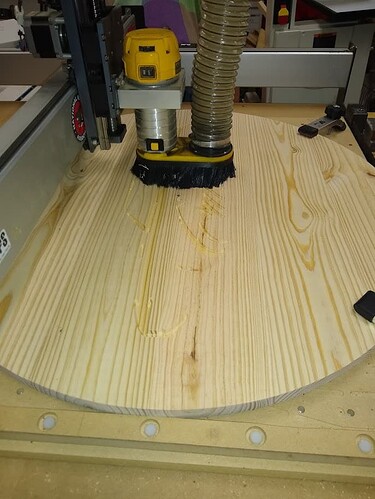OK, I have experimented and experimented and cannot seem to find a good font, bit and depth when carving text into oak that has Oramask on it. If I find a good font and depth, it seems the tool rips the Oramask up and it is not able to paint the cut.
The font right now that I am trying to do is about 3/4" high.
I was hoping that someone maybe had a file from their past projects that they could share.
Seems I spend so much more work on testing than I do on my projects.
What is a good bit when using Oramask?
What is a good font?
What is a good depth?
Welcome to reality. There is no absolute setting that will not rip the oramask or any other masking. To aid in not peeling the mask be sure to use a J roller on the mask when applying. Just putting hand pressure will not do it. I use oramask but I also use Easy Shelf Adhesive Liner that I get from Walmart. It is cheaper.
The bad news is even the best adhered mask will rip in places. Usually in cross grain cutting because the fibers are lifted up and therefore lift up the masking.
Another strategy for the material before masking is using dewaxed shellac or a coat or two of polyurethane. This hardens up the surface and then letting it dry thoroughly and then applying the masking and using a j roller gives you the best chance of a rip free experience.
Sorry for the bad news but that is the way the mask crumbles.
Make sure your bits are sharp. If they are getting worn out they tear out more. You can simply run your finger across the edge and feel if it is sharp. Not down the blade but across the edge so as to not cut your finger. If it feels sharp you will be able to tell. If it is dull you will also be able to tell. A diamond stone will touch a bit and there are many videos on youtube about sharpening a bit.
If you want to splurge, you could try a downcut VBit.
I haven’t had a chance to use mine yet, but I have good hopes that it will perform way better than the usual geometry.
I bought one of those Groovee Jenny 60 degree down cut vee bit. It is fantastic. The only issue is it has a very short shank. So I seat it in the collet about an inch to get a good grip on the bit. This usually means I cannot use my dust boot on my dust collection. I am afraid it will drag on the work and give me issues. I may still run the dust collector but it does not collect much dust that way. I have a Dewalt 611 router and the dust collection hose in in front of the router. My dust boot is not adjustable for height like the C3D one. So I make a mess with my Groovee Jenny. The good news is it does a fantastic job of cutting without a lot of fuzzies left behind. I can highly recommend it with the one caveat above.
Here is a vee carve in pine which is about the worst case for vcarving. It looks very smooth.
This is a side view of my dust collection shoe. I have two brushes, one short (shown) and a longer one for my long bits.
So the Groovee Jenny works well but I wish it had a longer shank.
I got my Groovee 60 degree for Christmas, I too have not used it as of yet, I also have high expectations as to its performance.
Here is my custom tool database for my groovee jenny bit.
| number | vendor | model | URL | name | type | diameter | cornerradius | flutelength | shaftdiameter | angle | numflutes | stickout | coating | metric | notes | machine | material | plungerate | feedrate | rpm | depth | cutpower | finishallowance | 3dstepover | 3dfeedrate | 3drpm |
|---|---|---|---|---|---|---|---|---|---|---|---|---|---|---|---|---|---|---|---|---|---|---|---|---|---|---|
| 702 | Cadance Mfg | Groovee Jenny | Groovee Jenny | vee | 0.375 | 0 | 0.375 | 0 | 60 | 3 | 1.5 | 0 | 20 | 35 | 18000 | 0.08 | 0.08 | 2 | 35 | 18000 |
Create a custom library and a custom tool for the Groovee Jenny. Then in CC pull down the Help Menu and About. Then select Open Data Directory. Then navigate to the CC directory and then tools. Double click on the custom library .csv file for your new library. The file will open in a spreadsheet. Edit what you want and then “Save As” a .csv file. Do not allow the file to be saved in the native spreadsheet format because CC cannot read that.
This topic was automatically closed after 30 days. New replies are no longer allowed.

